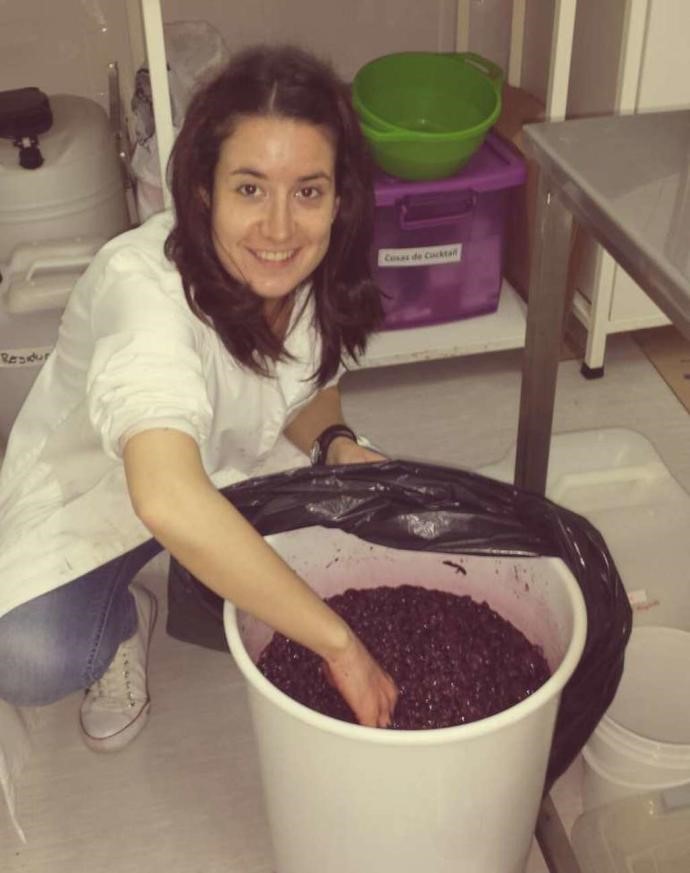By José Manuel Mirás-Avalos, Yolanda Bouzas-Cid, Emiliano Trigo-Córdoba, Ignacio Orriols and Elena Falqué
Aroma compounds accumulate in grapes during ripening, although their concentrations depend on temperature and water availability (Robinson et al., 2014), which can be altered by climate change, raising a great concern in viticulture regions worldwide (Fraga et al., 2013). In order to counteract these alterations, irrigation in vineyards is increasing, even in cool-humid regions (Balint & Reynolds, 2017). Recently, the effects of water stress on the amino acid and volatile composition of grapes and wines have been determined on white cultivars (Bouzas-Cid et al., 2018; Vilanova et al., 2019). However, these effects depend on grapevine cultivar, intensity of water stress, irrigation strategy and climate conditions.
The current study aimed at assessing the volatile composition and sensory profile of wines from Vitis vinifera (L.) cultivar Godello under rain-fed (R) and two drip irrigation systems (above, drip irrigation (DI), and under the soil surface, subsurface drip irrigation (SDI)) over three consecutive years (2012-2014) in NW Spain. The treatments were laid out in randomized blocks with four replications, as described by Cancela et al. (2016) in which further information regarding grapevine physiology and vine performance can be found. Irrigation was applied from July to late-August; the average amount of water applied was 1.5 mm day-1. General parameters of musts and wines were determined following official protocols. Amino acid concentrations in musts were determined by high-performance liquid-chromatography, wine volatiles were quantified by gas chromatography (Bouzas-Cid et al., 2018) and a characterization of the sensory attributes of the wines was performed (Mirás-Avalos et al., 2019). Statistical treatment of the data included ANOVA and principal component analysis (PCA).
Grapevine water status over the growing season differed between treatments and years (Figure 1), showing intensities of water stress between low and moderate, explaining the absence of significant differences among treatments in yield and cluster weight (Cancela et al., 2016).

Overall, irrigation tended to increase must (up to 15% in SDI) and wine total acidity (up to 11% in SDI) when compared to R; however, it did not alter must amino acid concentrations (Mirás-Avalos et al., 2019). Wines from SDI showed the highest total acidity and the lowest pH values (Mirás-Avalos et al., 2019), as common under weak or mild stress (Cancela et al., 2016; Balint and Reynolds, 2017).
Regarding wine volatile composition, irrigation reduced methanol concentration (by 15.5% in SDI) and tended to decrease the concentrations of compounds giving fruity aromas, such as acetaldehyde (by 31% in SDI), isoamyl acetate (by 21% in SDI) and citronellol (by 36% in SDI), when compared to R (Mirás-Avalos et al., 2019). When grouped by families, DI increased the concentration of higher alcohols in 2013 and SDI increased that of short-chained fatty acids in 2014 (Figure 2). Overall, SDI increased higher alcohol concentrations by 7%, while reduced those of acetates and terpenes, by 21% and 14% respectively, when compared to R.

Sensory analysis revealed slight differences among treatments for aroma descriptors. Wines from R received greater marks for fresh, dry and tropical fruit notes than wines from the irrigated treatments, especially from SDI (Figure 3). Godello wines from irrigated vines were more acidic but showed an aroma complexity similar to that of wines from R. These slight differences were caused by the low intensity of water stress experienced by vines (Cancela et al., 2016; Figure 1).

When applying a PCA to the aroma descriptors and the families of volatile compounds quantified in Godello wines (Figure 4), 66% of the variability in the samples was explained. This analysis separated the wines from each year, but not by treatment (Figure 4). Grouping wines from the same year is consistent with other reports (Vilanova et al., 2019), proving that in-season effects caused by irrigation were less important than weather conditions.

Under the climate conditions of Northwest Iberian Peninsula, irrigation had a low incidence on amino acid and volatile composition of Godello musts and wines, because of the weak level of water stress experienced by vines. This study showed that irrigation decreased the concentration of volatile compounds providing fruity aromas, leading to slight differences in wine perception by tasters. These results should be of interest to grape growers, winemakers and other wine professionals.
Those interested in the full-length report can download it at:
https://www.mdpi.com/2304-8158/8/4/135/htm

José Manuel Mirás-Avalos received, in 2004, his Ph.D. degree in Biology by the Universidade da Coruña (UDC). After a post-doctoral stay in the Avignon Center of the Institute de la Recherche Agronomique (INRA, France), he joined the Station for Viticulture and Enology Research (EVEGA-AGACAL) of the Xunta de Galicia (Spain), where he worked, for more than four years, as a researcher on the effects that agricultural practices may exert on grape yield and wine composition. He followed this line of research in the University of Santiago de Compostela (USC, Spain) for one year. Then, he joined the Department of Irrigation at the Centro de Edafología y Biología Aplicada del Segura (CEBAS-CSIC) in Murcia (Spain), where he is currently working on modelling irrigation and fertigation requirements of different crops.

Yolanda Bouzas-Cid received, in 2017, her Ph.D. degree in Food Science and Technology by the Universidade de Vigo (UVigo). Currently, she is working at the Station for Viticulture and Enology Research (EVEGA-AGACAL) of the Xunta de Galicia (Spain).

Emiliano Trigo-Córdoba is a Technical Agricultural Engineer by the Universidad de Sevilla, an enologist by the Universidad de Cádiz and received, in 2016, his Ph.D. degree in Agronomy by the Universidade de Santiago de Compostela (USC). He has performed research stays in centers from South America (Argentina, Chile and Uruguay), where he supported research on vineyard irrigation. Currently, he is working as a technician in an agricultural cooperative in Sevilla province (South Spain).

Ignacio Orriols received, in 1994, his Ph.D. degree in Chemistry by the Universidade de Santiago de Compostela (USC). He is also an specialist in Viticulture and Enology by the Universidad Complutense de Madrid. He performed post-doctoral stays in France and Italy. From 2003 to 2013, he was the director of the Station for Viticulture and Enology Research (EVEGA-AGACAL) of the Xunta de Galicia (Spain), where he supervised a great number of projects dealing with different topics in the fields of Wine Chemistry and Sensory perception.

Elena Falqué received, in 1998, her Ph.D. degree in Chemistry by the Universidade de Vigo (UVigo). She performed postdoctoral research stays in France and Portugal. Nowadays, she is professor at the Analytical and Food Chemistry Department of the Universidade de Vigo (Campus of Ourense), where she develops several research lines dealing with Wine Chemistry and characterization of the Galician grapevine varieties.
References
- Balint, G.; Reynolds, A.G. 2017. Irrigation level and time of imposition impact vine physiology, yield components, fruit composition and wine quality of Ontario Chardonnay. Sci. Hortic. 214, 252–272.
- Bouzas-Cid, Y.; Falqué, E.; Orriols, I.; Mirás-Avalos, J.M. 2018. Effects of irrigation over three years on the amino acid composition of Treixadura (Vitis vinifera L.) musts and wines, and on the aromatic composition and sensory profiles of its wines. Food Chem. 240, 707–716.
- Cancela, J.J.; Trigo-Córdoba, E.; Martínez, E.M.; Rey, B.J.; Bouzas-Cid, Y.; Fandiño, M.; Mirás-Avalos, J.M. 2016. Effects of climate variability on irrigation scheduling in white varieties of Vitis vinifera (L.) of NW Spain. Agric. Water Manage. 170, 99–109.
- Fraga, H.; Malheiro, A.C.; Moutinho-Pereira, J.; Santos, J.A. 2013. Future scenarios for viticultural zoning in Europe: Ensemble projections and uncertainties. Int. J. Biometeorol. 57, 909–925.
- Mirás-Avalos, J.M.; Bouzas-Cid, Y.; Trigo-Córdoba, E.; Orriols, I.; Falqué, E. 2019. Effects of two different irrigation systems on the amino acid concentrations, volatile composition and sensory profiles of Godello musts and wines. Foods 8(4), 135; doi: 10.3390/foods8040135
- Robinson, A.L.; Boss, P.K.; Solomon, P.S.; Trengove, R.D.; Heymann, H.; Ebeler, S.E. 2014. Origins of grape and wine aroma. Part 1. Chemical components and viticultural impacts. Am. J. Enol. Vitic. 65, 1–24.
- Vilanova, M.; Fandiño, M.; Frutos-Puerto, S.; Cancela, J.J. 2019. Assessment fertigation effects on chemical composition of Vitis vinifera L. cv. Albariño. Food Chem. 278, 636–643.

